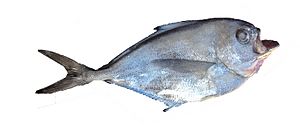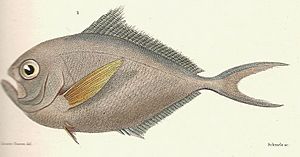Southern Ray's bream facts for kids
Quick facts for kids Southern Ray's bream |
|
|---|---|
 |
|
| Scientific classification | |
| Synonyms | |
|
Brama chilensis Guichenot, 1848 |
The Brama australis is a type of fish also known as the Southern Ray's bream or Pacific pomfret. It is a ray-finned fish that belongs to the pomfret family, called Bramidae. You can find this fish in the southern parts of the world's oceans.
Contents
What Does the Southern Ray's Bream Look Like?
The Southern Ray's bream has a body that is flat on the sides, much like other pomfret fish. It has one fin on its back, called a dorsal fin. This fin does not have sharp spines, but it does have stiff rays. The fin on its belly, called the anal fin, also has no spines. It looks a lot like the dorsal fin, but it's not as tall at the front.
This fish can grow up to about 53 centimeters (21 inches) long.
Where Does the Southern Ray's Bream Live?
You can find the Southern Ray's bream in the warm and cool waters of the Southern Pacific Ocean. This area stretches from New Zealand all the way to Chile. It might even live all around the Southern Hemisphere, below 20 degrees South latitude. This fish travels a lot, moving from one place to another.
Life and Habits of the Southern Ray's Bream
The Southern Ray's bream is a pelagic fish. This means it lives in the open ocean, not usually near the bottom or the shore. It can be found at depths from about 15 to 120 meters (49 to 394 feet).
This fish is a meat-eater. In the southern summer, off the coast of Chile, it mostly eats small shrimp-like creatures called krill. It also eats other small sea animals like crustaceans and amphipods. Sometimes, it will eat crabs, squids, and even small fish.
The Southern Ray's bream moves around a lot. It grows quite quickly and can reach its full size in about 8 to 9 years. Like many animals, this fish can sometimes have tiny creatures called parasites living on or inside it.
How Do People Use Southern Ray's Bream?
People mainly catch the Southern Ray's bream using long lines and nets. This is often done by small-scale fishers off the coast of Chile. Many of these fish are caught, so it's important to make sure there are enough left for the future. Sometimes, this fish is caught by accident when people are fishing for other types of fish, like tuna. This is called bycatch.
Images for kids
See also
 In Spanish: Reineta para niños
In Spanish: Reineta para niños




